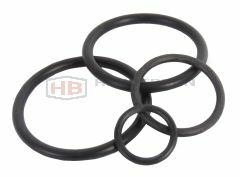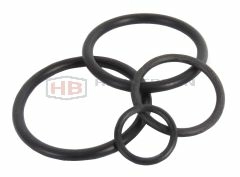- Home
- Sealing Products
- O Rings
O Rings - 2.62mm - 138.24mm - 35.07mm
O Rings are essential sealing elements used widely in various industries, designed to prevent leaks and enhance system integrity.
About O Rings
These versatile seals are crucial in numerous applications, functioning effectively by fitting into grooves and compressing between two or more parts to create a reliable seal. They are particularly useful in dynamic environments as well as in static conditions such as pipelines or tanks.
Common materials for O Rings include Nitrile (Buna-N), Viton® (FPM, FKM), Neoprene® (CR), EPDM, and Silicone (VMQ), each offering unique properties that cater to varying operational demands and environmental factors.
O Rings come in diverse sizes and material makeups to meet specific industry needs, providing options in terms of chemical compatibility, resilience, and overall durability.
If you need assistance selecting the right O Ring for your application or have specific requirements, please contact our sales team at Tel:-01425-477787, or email sales@hendersonbearings.co.uk.
What are O Rings and why are they important in various industries?
O Rings are circular sealing elements designed to prevent leaks and maintain system integrity across multiple industries. They fit snugly into machined grooves to form tight seals, crucial in both dynamic movements and static conditions.
How do I select the right O Ring for my application?
Choosing the right O Ring requires considering the specific conditions it will be exposed to, including pressure, temperature, and chemical environment. The material of the O Ring (such as Nitrile, Viton®, Neoprene®, EPDM, or Silicone) should be selected based on these factors for optimal performance and durability.
What are the common uses of O Rings?
O Rings are versatile and used in many industries, including automotive, aerospace, and manufacturing. They are particularly valuable in systems where precise sealing is necessary, such as in fluid transfer equipment, hydraulic and pneumatic systems, and various types of pumps and valves.
Can O Rings fail, and how can I tell if they need replacing?
O Rings can fail due to wear and tear, improper sizing or material choice, or degradation from chemicals or temperatures. Signs of failure include leakage, visible cracking or brittleness, and loss of flexibility or shape. Regular inspection and maintenance can help identify when replacements are needed.
- Outside Diameter 138.24mm Remove This Item
- Outside Diameter 35.07mm Remove This Item
- O Ring Cross Section 2.62mm Remove This Item
- 6.48mm 1 item
- 7.3mm 1 item
- 8.08mm 1 item
- 8.87mm 1 item
- 9.66mm 1 item
- 10.47mm 1 item
- 11.26mm 1 item
- 12.84mm 1 item
- 14.43mm 1 item
- 15.16mm 1 item
- 16.02mm 1 item
- 17.15mm 1 item
- 17.61mm 1 item
- 17.94mm 1 item
- 18.34mm 1 item
- 19.19mm 1 item
- 20.32mm 1 item
- 20.78mm 1 item
- 21.12mm 1 item
- 22.37mm 1 item
- 22.7mm 1 item
- 23.1mm 1 item
- 23.96mm 1 item
- 25.53mm 1 item
- 25.88mm 1 item
- 27.14mm 1 item
- 27.47mm 1 item
- 28.71mm 1 item
- 29.05mm 1 item
- 30.31mm 1 item
- 31.89mm 1 item
- 33.49mm 1 item
- 35.07mm 1 item
- 36.66mm 1 item
- 38.24mm 1 item
- 39.84mm 1 item
- 41.41mm 1 item
- 43.01mm 1 item
- 44.59mm 1 item
- 46.19mm 1 item
- 47.76mm 1 item
- 49.36mm 1 item
- 50.94mm 1 item
- 52.54mm 1 item
- 54.14mm 1 item
- 55.71mm 1 item
- 57.31mm 1 item
- 58.88mm 1 item
- 60.49mm 1 item
- 62.06mm 1 item
- 63.66mm 1 item
- 65.24mm 1 item
- 66.84mm 1 item
- 68.41mm 1 item
- 70.01mm 1 item
- 71.59mm 1 item
- 73.19mm 1 item
- 74.76mm 1 item
- 76.36mm 1 item
- 77.94mm 1 item
- 79.54mm 1 item
- 81.12mm 1 item
- 82.74mm 1 item
- 85.84mm 1 item
- 87.46mm 1 item
- 89.04mm 1 item
- 93.82mm 1 item
- 100.17mm 1 item
- 106.52mm 1 item
- 112.87mm 1 item
- 119.22mm 1 item
- 125.57mm 1 item
- 131.91mm 1 item
- 138.24mm 1 item
- 144.62mm 1 item
- 150.97mm 1 item
- 157.31mm 1 item
- 163.67mm 1 item
- 170.02mm 1 item
- 176.37mm 1 item
- 182.72mm 1 item
- 189.07mm 1 item
- 195.42mm 1 item
- 201.77mm 1 item
- 208.12mm 1 item
- 214.47mm 1 item
- 220.82mm 1 item
- 227.17mm 1 item
- 233.52mm 1 item
- 239.87mm 1 item
- 246.22mm 1 item
- 252.57mm 1 item



